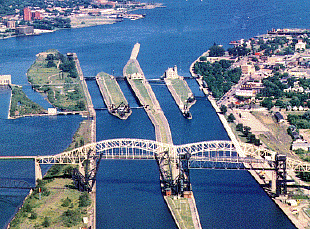Operated by the U.S. Army, Corps of Engineers Watching the huge vessels pass through the Soo locks is a unique experience that cannot be seen anywhere else in the United States. There are locks in the 26 mile Welland Canal, built to bypass Niagara Falls, but the maximum size vessel is 740' long and 78' wide. The locks at the Soo will hold the huge 1000' freighters used on the Great Lakes. You can watch the "Lakers" and the "Salties"(ocean-going vessels) as they travel the seaway between ports and see them rise or drop the 21 feet between the levels of the St. Mary's River. There is an upper viewing area so you are able to look down on the vessels as they lock through or stand almost close enough to touch them. The Visitors Center has a schedule of arriving vessels and general information such as size, cargo, destination, etc. There are also TV's so you can watch the vessels as they approach the locks from the St. Mary's River. Within the Visitors Center are charts, maps, artifacts, photographs, a working model of the locks, and a film presentation.
The locks operate most of the year, but are closed from Jan 15 to March 25 for maintenance. The locks are closed for longer periods if the weather is severe. The Poe and the MacArthur Locks are in use at this time. The MacArthur is the lock closest to the viewing area and will handle vessels up to 800 feet long, 80 feet wide and 31 feet deep.
The big 1000' Lakers need to use the second lock (The Poe) that is 1200' long, 110' wide and 32 feet deep, but you can still get close enough for a really good view. The MacArthur Lock was built in 1943 and the Poe Lock was built in 1968. The two other locks, Davis and Sabin are closed. The Davis Lock was built in 1918 and the Sabin Lock was built in 1919. Both these locks are too shallow (only 23 feet deep). A new and even bigger lock is planned which would take up the space now used by the Davis and the Sabin, but funding has not yet been made available. Cargo carried by some of the vessels might include iron ore (usually taconite pellets) limestone, coal, grain, cement, salt or sand. The huge freighter in the picture is a self-unloader carrying taconite pellets to Cleveland, Lorain, Chicago, Gary, Burns Harbor, Indiana Harbor, Detroit, Toledo, Ashtabula, Conneaut, or another iron ore receiving port. Many different types of vessels pass through the locks each year, from small passenger boats to the huge vessels carrying over 72,000 tons in cargo. Approximately 5,000 boats use the locks yearly. The number of boats using the canal has decreased as the size of the boats has increased.
Check out what is happening right now at the locks with the Soo Locks Live Web Cam Engineers Day: Last Saturday in June
Lodging. Businesses & Attractions in Sault Ste. Marie, MI, the oldest city in Michigan
Top Photo, U.S. Army, Corps of Engineers Back to Recreation & Attractions |




